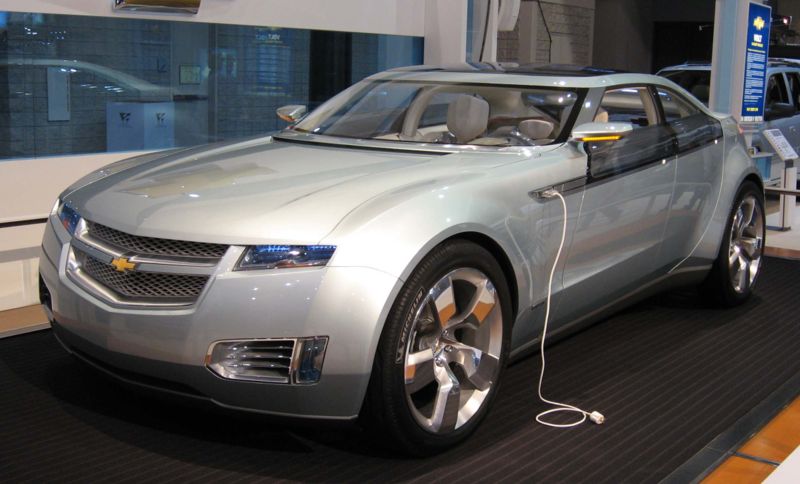
* Looks like: A sporty, squinty-eyed concept car
* Defining characteristics: 150 mpg, clear plastic roof and side windows, 3-D gauges
* Ridiculous features: Partner General Electric contributed ... plastic
* Chance of being mass-produced: The Volt is in question, but count on a series hybrid
The four-seat Chevrolet Volt concept is more than just another in a long line of hybrid experiments to come out of the auto industry, and more than just another promise from GM. Actually, it is just a promise at this time, but it's one of the most significant hybrid developments to date. The Volt is a plug-in hybrid, but its E-flex drivetrain uses only an electric motor under battery power to propel itself. What makes it different from a pure battery/electric car is an onboard generator powered by a small gasoline engine.
Two things make the Volt significant. The first is that it can be plugged into a household electric socket and charged fully within about six hours, allowing it to drive roughly 40 miles on electricity alone. GM points out that more than 75 percent of Americans live within 20 miles of where they work, which makes the Volt an all-electric, zero-emissions commuter car. If the battery does run down, the 1.0-liter, three-cylinder gas engine charges the battery and provides power to keep on driving up to 600 additional miles. E-flex is what's called a series hybrid, as opposed to the many Hondas, Toyotas and other hybrids sold now, which are parallel hybrids.
We know from covering early hybrids that most people assumed they were plug-in electric cars that drove in all-electric mode until the charge depleted, and then switched to gas power. Hybrid manufacturers have spent untold marketing money explaining to Americans that hybrids don't need to be plugged in and that they operate just like any other car. Research had shown that having to plug in a car was seen as a deterrent.
The Volt is exactly what many people originally thought hybrids were — and feared. What has changed? Gas prices have skyrocketed and current hybrids have earned widespread acceptance. When in electric mode, Chevy says, the Volt operates at about 2 cents per mile. (Even at today's cost per gallon of gas, a car that gets 25 mpg costs about 8 cents per mile.) Unlike GM's first electric car, the controversial EV-1, the Volt doesn't require a special charging station. Any 110-volt outlet will do.
Chevy says the Volt gets 50 mpg with the generator running in what's called range-extender mode. In a 60-mile round trip, with the last 20 miles in this mode, the car burns enough gas to result in a 150 mpg equivalent for the trip. When running on E85, which is 15 percent gas, you could travel 525 miles before burning a gallon's worth of gasoline. Though the ethanol component still produces pollution and carbon dioxide, at least it is a domestic renewable fuel, not foreign petroleum.
The second significant aspect is that the gasoline-driven generator, which also runs on E85, could be replaced by any other engine type — diesel, biodiesel, pure ethanol — or a hydrogen fuel cell. No single alternative fuel could replace petroleum; it will take multiple sources to even make a dent. The E-flex principle would allow people to chose their engine based on fuel availability and prices in their region.
The Volt is extremely clean. When in battery/electric mode, it produces no emissions. Aside from the fact that it runs less often, the Volt's gas engine is small, and it produces less carbon dioxide when it's running. It operates from 1,500 rpm to 3,000 rpm when generating electricity, with 1,800 rpm the nominal speed. It's much easier for engineers to control pollution emissions over such a narrow range of engine speeds. Though household electricity doesn't often come from clean sources, the E-flex drivetrain itself would reduce emissions in smog-prone areas like Los Angeles. And electricity comes from domestic sources like coal and natural gas.
It shouldn't surprise anyone that the Volt concept is a sporty-looking number. The EV-1 was sporty, if odd-looking. With their prodigious power (torque, actually) at low rpm, electric motors put even diesels to shame. The Volt, while not a rocket, is claimed to do zero to 60 mph in 8 to 8.5 seconds, with a top speed of 125 mph. How long it might be before we see a car like the Volt is tough to predict. GM says the lithium-ion battery technology required for the performance specified won't be mature enough until 2010 to 2012, though it could easily take as long to develop the car itself. The more common nickel-metal-hydride battery available today would weigh about 40 percent more, and weight reduction is critical. Though the battery pack weighs almost 400 pounds, the gas engine and fuel tank are smaller and lighter. Overall, the drivetrain's weight isn't dramatically different from a conventional one, but the Volt concept makes extensive use of plastics and composites from GE to keep the weight down to its 3,140 pounds. There's plenty of work yet to do.









No comments:
Post a Comment